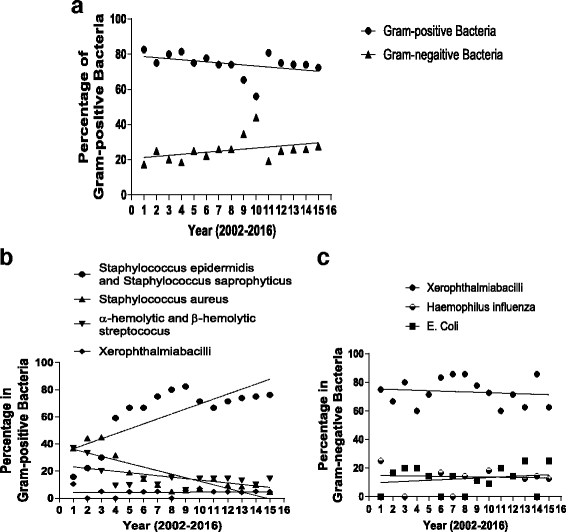A chronological study of the bacterial pathogen changes in acute neonatal bacterial conjunctivitis in southern China
- PMID: 28950852
- PMCID: PMC5615761
- DOI: 10.1186/s12886-017-0570-8
A chronological study of the bacterial pathogen changes in acute neonatal bacterial conjunctivitis in southern China
Abstract
Background: The aim of the project is to retrospectively study the changes in bacterial pathogens in acute neonatal bacterial conjunctivitis from 2002 to 2016 in Southern China. The results may provide the guidance for drug choice for acute neonatal bacterial conjunctivitis.
Methods: Secretion specimens for bacterial culture were taken from 485 cases with clinically diagnosed acute bacterial neonatal conjunctivitis. Bacterial pathogens were detected by Gram staining and subsequent bacterial culture.
Results: From the analysis of the bacterial pathogens in 485 cases of acute neonatal conjunctivitis patients from 2002 to 2016 in Southern China, there is an overall trend of decreasing detection of Gram-positive bacteria and increasing detection of Gram-negative bacteria from the conjunctival sac secretions. Gram-positive bacteria in the bacteria-positive samples dropped year by year from 82.6% in 2002 to 72.4% in 2016. Accordingly, the ratio of Gram-negative bacteria increased from 17.4% in 2002 to 27.6% in 2016. Of note, despite the overall trend, there was a significant increase in detection of Gram-positive bacteria and decrease in detection of Gram-negative bacteria from 2011 to 2012. Among the Gram-positive bacteria, there is a trend of increasing percentage of the opportunistic pathogens (an ~60% increase in Staphylococcus epidermidis and Staphylococcus saprophytic) and decreasing percentage of Staphylococcus aureus (~30% decrease) and hemolytic streptococcus (~20% decrease) in the last 15 years. The main Gram-negative bacterium is Neisseria gonorrhoeae. Overall, there is a change in the pattern of bacterial species in acute neonatal bacterial conjunctivitis in Southern China in the last 15 years.
Conclusion: Our study provides a trend analysis of the bacterial pathogens in the conjunctival sac secretions of the acute neonatal bacterial conjunctivitis patients in Southern China in recent years. This data could provide useful information regarding the treatment options for neonatal bacterial conjunctivitis.
Keywords: Bacterial conjunctivitis; Neonates; Pathogens.
Conflict of interest statement
Ethics approval and consent to participate
The study was conducted in compliance with informed consent regulations and the Declaration of Helsinki. The study protocol was approved by internal review board (IRB) of Shenzhen Eye Hospital (IRB#: 200,220,111). Informed consent was obtained from the parents of the patients for the study.
Consent for publication
Informed consent was obtained from the patients for the study. Since the study contains no individual persons’ data, there is no requirement for consent to publish.
Competing interests
The authors declare that they have no competing interests.
Publisher’s Note
Springer Nature remains neutral with regard to jurisdictional claims in published maps and institutional affiliations.
Figures

Similar articles
-
Ophthalmia neonatorum in the United Arab Emirates.Ann Trop Paediatr. 1996 Mar;16(1):27-32. doi: 10.1080/02724936.1996.11747800. Ann Trop Paediatr. 1996. PMID: 8787362
-
Shifting trends in bacterial keratitis in Toronto: an 11-year review.Ophthalmology. 2012 Sep;119(9):1785-90. doi: 10.1016/j.ophtha.2012.03.031. Epub 2012 May 23. Ophthalmology. 2012. PMID: 22627118
-
Bacterial Keratitis in Toronto: A 16-Year Review of the Microorganisms Isolated and the Resistance Patterns Observed.Cornea. 2017 Dec;36(12):1528-1534. doi: 10.1097/ICO.0000000000001390. Cornea. 2017. PMID: 28938380
-
Neonatal Bacterial Conjunctivitis in Korea in the 21st Century.Cornea. 2017 Apr;36(4):415-418. doi: 10.1097/ICO.0000000000001122. Cornea. 2017. PMID: 28002109 Review.
-
Literature review on the distribution characteristics and antimicrobial resistance of bacterial pathogens in neonatal sepsis.J Matern Fetal Neonatal Med. 2022 Mar;35(5):861-870. doi: 10.1080/14767058.2020.1732342. Epub 2020 Feb 26. J Matern Fetal Neonatal Med. 2022. PMID: 32102584 Review.
Cited by
-
Bacteriological profiles and drug susceptibility of Streptococcus isolated from conjunctival sac of healthy children.BMC Pediatr. 2020 Jun 22;20(1):306. doi: 10.1186/s12887-020-02203-9. BMC Pediatr. 2020. PMID: 32571257 Free PMC article.
-
Incidence and Clinical Characteristics of Infantile Conjunctivitis in a Western Population.Am J Ophthalmol. 2022 Sep;241:145-148. doi: 10.1016/j.ajo.2022.04.008. Epub 2022 Apr 22. Am J Ophthalmol. 2022. PMID: 35469786 Free PMC article.
-
Lacrimal sac bacteriology and susceptibility pattern in infants with congenital nasolacrimal duct obstruction in the 1st year of life: a cross-sectional study.BMC Pediatr. 2020 Oct 6;20(1):465. doi: 10.1186/s12887-020-02358-5. BMC Pediatr. 2020. PMID: 33023519 Free PMC article.
-
Is it necessary to use tobramycin-dexamethasone eye ointment prophylactically in eyes at the end of intraocular surgery?BMC Ophthalmol. 2020 May 27;20(1):208. doi: 10.1186/s12886-020-01476-z. BMC Ophthalmol. 2020. PMID: 32460732 Free PMC article.
-
The Growing Threat of Gonococcal Blindness.Antibiotics (Basel). 2018 Jul 12;7(3):59. doi: 10.3390/antibiotics7030059. Antibiotics (Basel). 2018. PMID: 30002340 Free PMC article.
References
-
- Ghosh S, Chatterjee BD, Chakraborty CK, et al. Bacteria in surface infections of neonates. J-Indian-Med-Assoc. 1995;93(4):132–135. - PubMed
-
- Li, Z., Zheng, J. and Li, J. Diagnostic bacteriology. Hong Kong:Yellow River Culture Press. the first Edition,1992;174–183.
MeSH terms
LinkOut - more resources
Full Text Sources
Other Literature Sources

